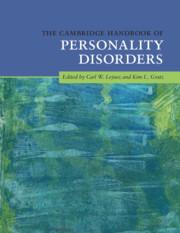Book contents
- The Cambridge Handbook of Personality Disorders
- The Cambridge Handbook of Personality Disorders
- Copyright page
- Contents
- Figures
- Tables
- Contributors
- Preface
- Part I Etiology
- 1 Neuroimaging in Personality Disorders
- 1a A Clinically Relevant Neuroscience for Personality Disorders: Commentary on Neuroimaging in Personality Disorders
- 1b Methodological Advancements Needed in Neuroimaging Research on Personality Disorders: Commentary on Neuroimaging in Personality Disorders
- 1c Illustrating the Value of Neuroimaging Studies Using the Example of Affect Regulation: Author Rejoinder to Commentaries on Neuroimaging in Personality Disorders
- 2 Issues and New Directions in Personality Disorder Genetics
- 2a Four Key Areas for Further Investigation: Commentary on Issues and New Directions in Personality Disorder Genetics
- 2b Highlighting the Value of Dimensional Conceptualizations and Environmental Influences: Commentary on Issues and New Directions in Personality Disorder Genetics
- 2c Questioning Current Directions in Personality Disorder Genetics: Author Rejoinder to Commentaries on Issues and New Directions in Personality Disorder Genetics
- 3 Environmental and Sociocultural Influences on Personality Disorders
- 3a Evidence for Caregiver Factors Proposed by Attachment and Biosocial Theories in the Development of Personality Disorders: Commentary on Environmental and Sociocultural Influences on Personality Disorders
- 3b Towards a Family Process Perspective on Typical and Maladaptive Personality Characteristics: Commentary on Environmental and Sociocultural Influences on Personality Disorders
- 3c Moving Contextual Personality Research Forward: Author Rejoinder to Commentaries on Environmental and Sociocultural Influences on Personality Disorders
- 4 Personality Pathology in Youth
- 4a Toward the Integration of Developmental Psychopathology and Personality Pathology Perspectives: Commentary on Personality Pathology in Youth
- 4b A Developmental Psychopathology Perspective on the Emergence of Antisocial and Borderline Personality Pathologies across the Lifespan: Commentary on Personality Pathology in Youth
- 4c Bridging Diverging Perspectives: Author Rejoinder to Commentaries on Personality Pathology in Youth
- Part II Models
- Part III Individual Disorders and Clusters
- Part IV Assessment
- Part V Treatment
- Index
- References
4c - Bridging Diverging Perspectives: Author Rejoinder to Commentaries on Personality Pathology in Youth
from Part I - Etiology
Published online by Cambridge University Press: 24 February 2020
- The Cambridge Handbook of Personality Disorders
- The Cambridge Handbook of Personality Disorders
- Copyright page
- Contents
- Figures
- Tables
- Contributors
- Preface
- Part I Etiology
- 1 Neuroimaging in Personality Disorders
- 1a A Clinically Relevant Neuroscience for Personality Disorders: Commentary on Neuroimaging in Personality Disorders
- 1b Methodological Advancements Needed in Neuroimaging Research on Personality Disorders: Commentary on Neuroimaging in Personality Disorders
- 1c Illustrating the Value of Neuroimaging Studies Using the Example of Affect Regulation: Author Rejoinder to Commentaries on Neuroimaging in Personality Disorders
- 2 Issues and New Directions in Personality Disorder Genetics
- 2a Four Key Areas for Further Investigation: Commentary on Issues and New Directions in Personality Disorder Genetics
- 2b Highlighting the Value of Dimensional Conceptualizations and Environmental Influences: Commentary on Issues and New Directions in Personality Disorder Genetics
- 2c Questioning Current Directions in Personality Disorder Genetics: Author Rejoinder to Commentaries on Issues and New Directions in Personality Disorder Genetics
- 3 Environmental and Sociocultural Influences on Personality Disorders
- 3a Evidence for Caregiver Factors Proposed by Attachment and Biosocial Theories in the Development of Personality Disorders: Commentary on Environmental and Sociocultural Influences on Personality Disorders
- 3b Towards a Family Process Perspective on Typical and Maladaptive Personality Characteristics: Commentary on Environmental and Sociocultural Influences on Personality Disorders
- 3c Moving Contextual Personality Research Forward: Author Rejoinder to Commentaries on Environmental and Sociocultural Influences on Personality Disorders
- 4 Personality Pathology in Youth
- 4a Toward the Integration of Developmental Psychopathology and Personality Pathology Perspectives: Commentary on Personality Pathology in Youth
- 4b A Developmental Psychopathology Perspective on the Emergence of Antisocial and Borderline Personality Pathologies across the Lifespan: Commentary on Personality Pathology in Youth
- 4c Bridging Diverging Perspectives: Author Rejoinder to Commentaries on Personality Pathology in Youth
- Part II Models
- Part III Individual Disorders and Clusters
- Part IV Assessment
- Part V Treatment
- Index
- References
Summary
This rejoinder is aimed at responding to the respective commentaries by Vernberg and Abel and Beauchaine; however, most of the rejoinder focuses on the commentary by Vernberg and Abel given the fact that Vernberg and Abel appear to challenge the basic premise that maladaptive traits denote personality disturbance beyond that of externalizing and internalizing disorder, which according to them, renders the concept of youth BPD obsolete. The authors of this rejoinder provide two points of rebuttal in this regard. First, while it is true that Axis I and II show a very similar empirical structure and can thus be represented from a unified perspective, the construct of youth BPD lies in the co-occurrence and interplay of specific symptoms. BPD is therefore more than a sum of its symptoms, and assessing these symptoms individually from established internalizing-externalizing measures (as Vernberg and Abel suggest) would not adequately capture the dynamics between symptoms that largely account for the downward spiral of BPD functioning. Second, they view the DSM-5 Criterion A function as the feature of personality pathology that distinguishes it from trait function; in particular the self-concept manifestations of Criterion A that are not readily captured by trait (Criterion B) personality function.
Keywords
- Type
- Chapter
- Information
- The Cambridge Handbook of Personality Disorders , pp. 99 - 100Publisher: Cambridge University PressPrint publication year: 2020

